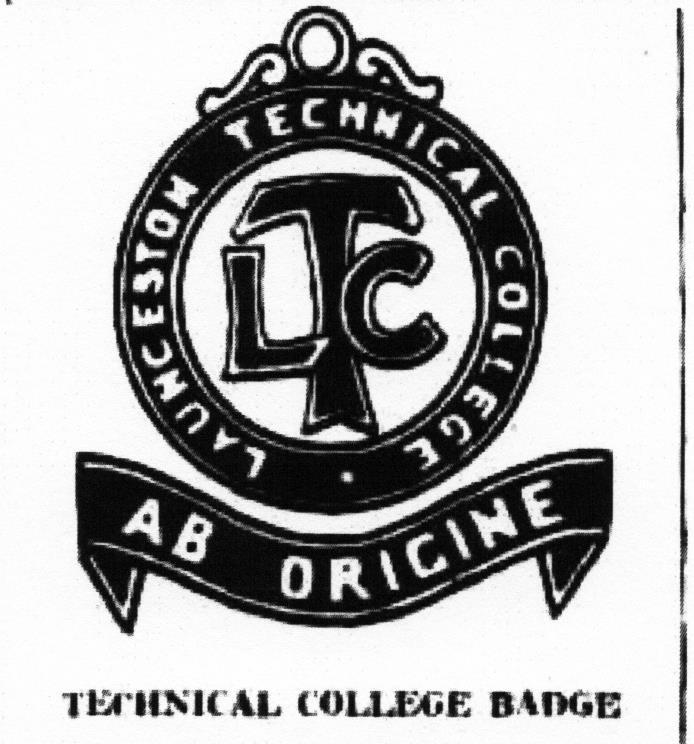The Launceston Junior Technical School, which commenced in 1919, grew out of the Government Launceston Technical School, later known as the Launceston Technical College, and till 1960, they had close associations. On the establishment of the Junior School, the former school became known as the Senior School with the College premises for many years being shared.
The first school providing technical subjects commenced in 1888, with changes in locality and subjects taught later occurring. A newspaper article appearing in the Launceston Examiner (18 November 1933) gives some details.
“The Launceston Technical School (now College) was established in 1888 and maintained by an annual Parliamentary grant in addition to the fees received from students. An inaugural meeting was held in the Town Hall on April 23, 1888 and at the close 58 young men gave their names as intending students. Classes were at once commenced in the Town Hall, with Mr. W. Schuetz as the first instructor. After a few months a move was made to rooms in the Quadrant and Mr. E. Bogle, the Government Inspector of Machinery, took charge of the machine construction and drawing class, which he conducted for many years with marked success and usefulness.
In 1890 part of the Government building in St. John Street was given up to the Technical School. The premises were specially fitted up, and several new classes added. There followed steady progress and development, not only in numbers attending and in the variety of subjects taught, but in the scope and quality of the work done. The institution eventually outgrew its premises. The rooms occupied were not suited to the purpose to which they were put and as the accommodation was required by the Government offices, including the Tourist Bureau, the Government approached the school authorities in 1908 with reference to the erection of a new building.
A new building was erected adjoining the Victoria Museum and Art Gallery, the land for which was donated by the Launceston City Council. It was completed during 1910 with improved accommodation, especially for the trade classes.
Up to that time the school was only of a senior nature, and fees were payable. In 1919 as a result of a joint report made to the Government by the Superintendent of Technical Education in New South Wales (Mr. J. Nangel) and the Director of Education in Tasmania, Mr. W.T. McCoy, the Junior School was established. The First Wing of the building was finished about 1920 and opened by the Premier of that time (Sir Walter Lee).
When the Beattie Collection was bought by the Council, the school offered to vacate the building adjoining the Museum on condition that the second wing of the proposed new building was erected as soon as possible. The Government set aside the money, but it was then that the depression came and the Public Works Department was forced to leave the matter in abeyance for a time. At the same time the old Court buildings were vacated and the school was given permission to make use of them.”
The old Court building had been scheduled for demolition soon after building the new Court in Cameron Street in 1930, but due to a lack of finance did not proceed for another 10 years. During this time the College made use of the building, in 1931 converting it to an assembly hall and doubling as a gymnasium. It was also used as a classroom. Further to provide a recreation area for the junior boys, the court site was cleared of various properties, a dilapidated cottage, cells and the like. The removals were undertaken as a working bee by junior boys during the lunch hour under the direction of the masters, improving the site appearance and giving more room for recreational activities.
The building of the Second Wing of the College got underway in 1933, fronting onto Paterson Street and was ready for occupation at the beginning of the first term in 1934. Four new class rooms became available in place of the five rooms that were temporally occupied in the Museum building.
The Third Wing of the College, located on the site of the old Supreme Court building, on the corner of Paterson and Wellington Streets, got underway in 1940. It was designed to connect the two existing wings, as designed in the 1920 plans.
A further change for the school occurred in 1940 with the Junior School being moved over Paterson Street to occupy the previous Wellington Square primary school, located in the 1917 built two storied brick building. The original 1900 building continued in use as a kindergarten for several years, then becoming part of the Tech. Junior School.
With growing student numbers at both the Senior and Junior schools, further school rooms became necessary and in 1954 two prefab blocks were built on the western end of the Square near Bathurst Street. These four class rooms were used by the school till the end of 1960 when the school fully moved to Queechy.
By Ivan Badcock – 23 March 2022


I really wanted to apply for do my father study in mechanical engineering as I live here at Launceston.
I have some of my fathers books and certificates from early 1940’s . Would you be interested in any of them ?